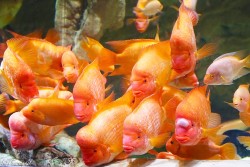Nanochromis nudiceps: A Comprehensive Guide to This Fascinating Dwarf Cichlid
 Nanochromis nudiceps, commonly known as the Congo dwarf cichlid, is a captivating and diminutive fish species that hails from the Congo River Basin in Africa. These small cichlids, which max out at around 3 inches in length, are prized among aquarium enthusiasts for their striking appearance, intriguing behavior, and manageable size.
Nanochromis nudiceps, commonly known as the Congo dwarf cichlid, is a captivating and diminutive fish species that hails from the Congo River Basin in Africa. These small cichlids, which max out at around 3 inches in length, are prized among aquarium enthusiasts for their striking appearance, intriguing behavior, and manageable size.In their natural habitat, Congo dwarf cichlids inhabit the shallow, slow-moving tributaries and streams of the Congo. They prefer areas with plenty of plant cover and debris where they can establish small territories. Males exhibit vivid orange and black coloration and are highly territorial, especially when breeding.
In the home aquarium, Congo dwarf cichlids require a heavily planted tank with plenty of hiding spots to retreat to. While males can spar, they are suitable for peaceful community tanks when provided with appropriate tank mates. Recreating their soft, acidic water is ideal. They readily spawn if given suitable conditions.
In this comprehensive guide, we'll delve further into the world of Nanochromis nudiceps, exploring their natural habitat preferences, dietary needs, breeding behaviors, tank requirements, compatibility with other species, and more. With their petite size and brilliant colors, Congo dwarf cichlids can make rewarding additions to planted nano aquariums.
Natural Habitat and Distribution
Nanochromis nudiceps is native to the lower Congo River Basin, which spans several Central African countries, including the Democratic Republic of Congo and the Republic of Congo. They inhabit slow-moving and densely vegetated waters, such as small streams, tributaries, and swampy areas. In the wild, these cichlids are accustomed to slightly acidic water conditions with soft substrate and abundant hiding spots among submerged vegetation and driftwood.
Physical Characteristics
1. Size: Adult Nanochromis nudiceps typically reach a size of 2 to 2.5 inches (5-6.5 cm), making them an ideal choice for smaller aquarium setups.
2. Coloration: These cichlids display exquisite coloration, with a base body color of pale yellow to cream, adorned with vibrant blue or turquoise markings on the face, dorsal fin, and pelvic fins. Males often boast more extended, striking fin extensions and brighter colors.
Tank Setup and Care
Providing the right environment and care is essential for the well-being of Nanochromis nudiceps:
1. Tank Size: A tank with a minimum capacity of 20-30 gallons is suitable for a pair of Nanochromis nudiceps.
2. Water Parameters: Maintain slightly acidic to neutral water conditions, with a pH range of 6.0-7.5, a water temperature between 76-82°F (24-28°C), and soft to moderately hard water with a hardness of 5-15 dGH.
3. Filtration and Water Quality: Ensure efficient filtration and perform regular water changes to maintain pristine water quality, as these cichlids can be sensitive to poor water conditions.
4. Substrate and Decor: Mimic their natural habitat by using fine sand or small-grain gravel substrate. Provide plenty of hiding spots using rocks, driftwood, and live or artificial plants. A well-structured aquarium with hiding places will help reduce stress and encourage natural behavior.
Diet and Feeding
Nanochromis nudiceps are omnivorous, and their diet should reflect a balance between animal and plant-based foods. Offer them a variety of high-quality foods, including:
- High-quality Cichlid Pellets: These provide essential nutrients for growth and overall health.
- Frozen and Live Foods: Offer occasional treats like bloodworms, brine shrimp, and small crustaceans to mimic their natural diet.
- Vegetables: Supplement their diet with blanched vegetables like spinach, zucchini, and peas.
Feed them small, frequent meals to accommodate their small size and rapid metabolism.
Behavior and Compatibility
Nanochromis nudiceps are generally peaceful, but they can become territorial during breeding. When it comes to tankmates, choose companions of similar size and temperament, such as small tetras, rasboras, or other peaceful dwarf cichlids. Avoid aggressive or large species that may intimidate or harm them.
Breeding Nanochromis nudiceps
Breeding Nanochromis nudiceps can be a rewarding experience. To encourage breeding, maintain excellent water quality and provide suitable hiding spots. The female will lay eggs in a sheltered location, and the male will guard and protect them. Once the fry hatch, they can be initially fed with baby brine shrimp and later transitioned to finely crushed flake foods.
Conclusion
Nanochromis nudiceps, the Congo Dwarf Cichlid, is a captivating addition to any freshwater aquarium. With their vibrant colors, interesting behavior, and manageable size, they are well-suited for both beginners and experienced aquarists. By recreating their natural habitat and providing proper care, you can enjoy the beauty and charm of these remarkable fish in your own home aquarium.
FAQ's
What is Nanochromis nudiceps?
Nanochromis nudiceps is a small, colorful cichlid species endemic to western Africa. Commonly known as the dwarf firemouth cichlid or rocket cichlid, it is popular in the aquarium trade for its bright orange and black coloration.
What is their natural habitat?
In the wild, Nanochromis nudiceps inhabits slow-moving rivers and streams with sandy substrates and plant debris. They are found in West Africa from Ghana to Nigeria.
What do dwarf firemouth cichlids eat?
Nanochromis nudiceps are primarily carnivores, feeding on insects, worms, and crustaceans in their native habitat. They readily accept frozen and live foods in captivity along with quality flake or pellet foods.
What size tank do they require?
A 20 gallon long aquarium is sufficient for a small group or pair of Nanochromis nudiceps. Provide plenty of rocks, driftwood, and plants for shelter and territory establishment.
Are rocket cichlids aggressive?
Males can be aggressive toward each other, especially when breeding. Otherwise, N. nudiceps are suitable community tank fish when kept with small, peaceful species.
How large do dwarf firemouths grow?
In most home aquariums, Nanochromis nudiceps reaches a maximum length of around 3-4 inches when fully grown and properly cared for.
